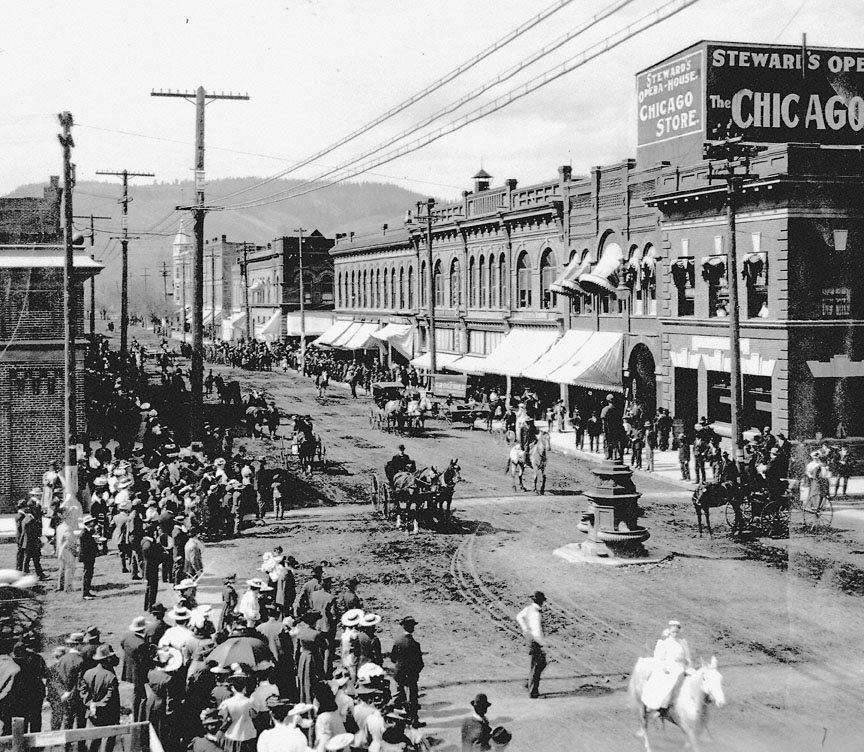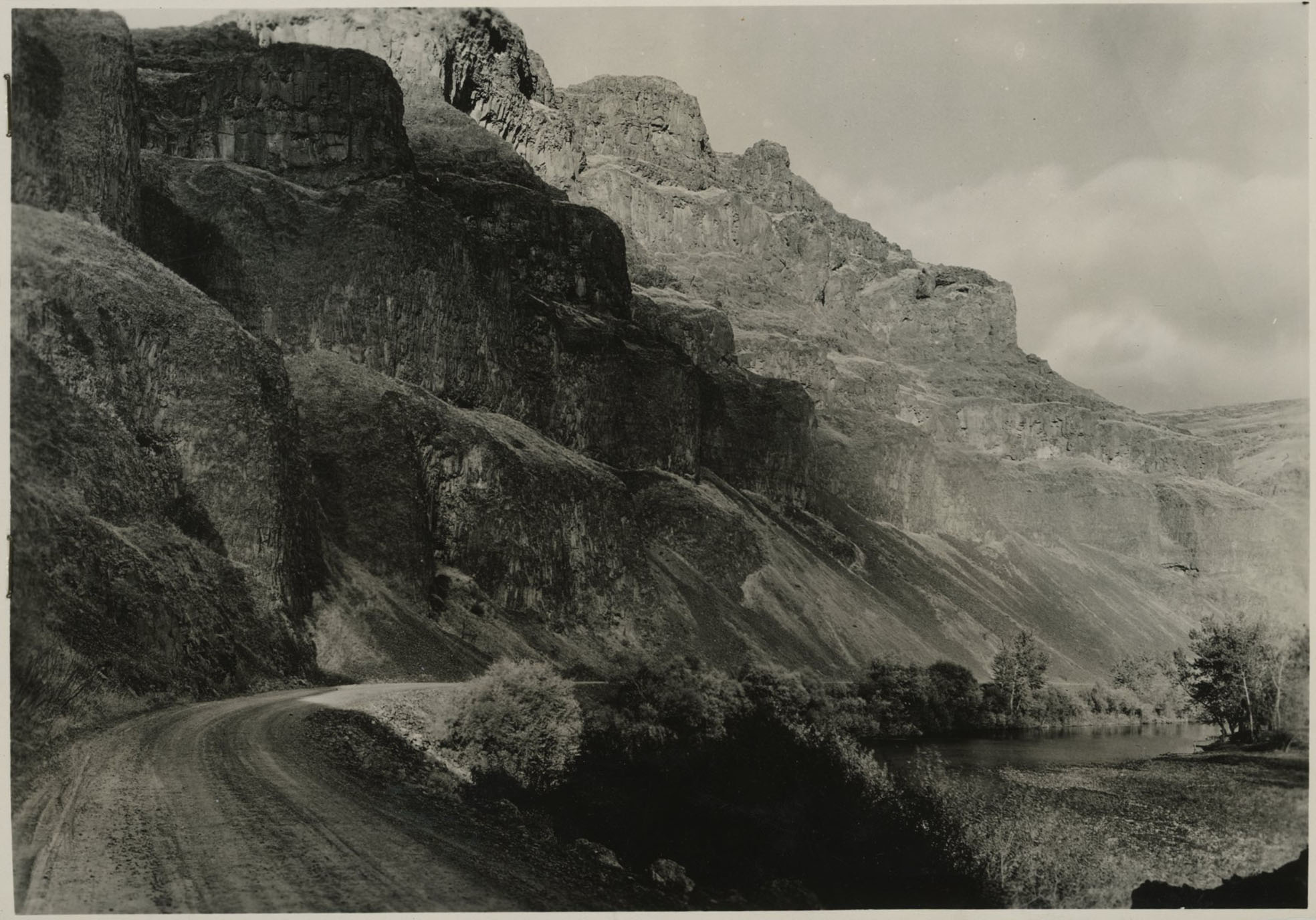La Grande, the seat of Union County, is nestled in the eastern foothills of the Blue Mountains. Situated in the Grande Ronde Valley, La Grande is the third largest city in eastern Oregon, with an estimated population of 13,026 in 2020.
The Oregon Trail passed through the Grande Ronde Valley, and La Grande was first settled in 1861 by immigrants originally bound for the Willamette Valley. One of the founding settlers, Benjamin Brown, was a community and business leader in the town, which was originally referred to as Brown’s Town or Brownsville. Because there was already a Brownsville in Linn County, the Post Office Department required a new name, and in 1863 a post office was established under the name La Grande. The city was incorporated in 1865.
There is some uncertainty regarding the origins of the town’s name. Most sources attribute it, along with the shared name of the river and valley—the Grande Ronde— to early French Canadian trappers describing the bowl-shaped valley, in which La Grande is situated. One possibly apocryphal claim is that a young Frenchman by the name of Charles Dause frequently used the phrase le grand ronde when referring to the sweeping views of the valley from town.
Before white settlement, the Grande Ronde Valley was an important rendezvous site for Native people of the southern Columbia Plateau. Umatilla, Nez Perce, Cayuse, and others traveled to the valley in the summer to harvest camas root and other plants and to hunt, fish, and trade. White settlement created competition for the land and its resources, and in 1862 a band of Umatilla challenged the newcomers’ right to claim land in the valley. U.S. soldiers who were sent to arrest three Umatilla chiefs who were involved in the dispute killed several men before the rest of the group could escape.
During the 1860s and 1870s, La Grande grew rapidly, as miners moving into the gold fields of Idaho and eastern Oregon provided a ready market for homesteaders’ agricultural products. La Grande’s importance as a commercial center grew when, in 1884, the Oregon Railway and Navigation Company (OR&N) completed its main trunk line through the town. The railroad drastically altered the landscape of La Grande, as businesses relocated from the original site of the town along the southwest edge of the valley to the flats near the proposed tracks and train depot.
During the late nineteenth century, La Grande, like many towns in the rural West, had a significant Chinese population. Many had come to work in the mines and on the railroads, and they stayed on as small business proprietors and agricultural laborers. On September 24, 1893, a mob of about two hundred armed men looted and burned some of the city’s Chinese businesses and homes and forcibly removed many Chinese residents by marching them to the nearby rail depot at Oro Dell and demanding that they leave the country. According to accounts in the La Grande Gazette the next week, some of the mob victims returned to settle their business affairs before leaving La Grande permanently. While the newspaper reported that the sheriff and others attempted to protect the Chinese, articles also noted that public sentiment opposed the presence of Chinese in the community. Over fifty men were arrested, ten of whom were indicted and charged with arson. All were found not guilty.
From 1875 to 1884, La Grande was home to Blue Mountain University, founded and operated by the Columbia River Conference of the Methodist Episcopal Church. In 1929, Eastern Oregon Normal School opened its doors as a teachers college. The Oregon legislature renamed the college Eastern Oregon State College in 1973; in 1997, it became Eastern Oregon University. The university, with an on-campus enrollment of about 1,600 students, is a major employer in La Grande and plays an important economic and cultural role in the region. It is the only state liberal arts university east of the Cascade Mountains.
La Grande, whose nickname is “The Hub City,” hosts the Eastern Oregon Film Festival, the Crossing the Blues Arts festival, and the Grande Ronde Symphony Orchestra. ArtsEast, home of the Eastern Oregon Regional Arts Council, was founded in 1977 as a nonprofit organization to deliver arts education and outreach programs in eastern Oregon.
With its proximity to the Blue and the Wallowa Mountains, La Grande is a popular year-round destination for outdoor enthusiasts, including hunters, campers, mushroomers, birders, cyclists, skiers, snowmobilers, and snowboarders. Nearby Anthony Lakes Ski Resort boasts some of the best powder snow in the Intermountain West. Five miles south of La Grande, the 6,000-acre Ladd Marsh Wildlife Area, a popular destination for birdwatchers and hunters, is the largest hardstem bulrush marsh in northeastern Oregon, offering a glimpse of what the valley was like before agricultural development.
-
![La Grande, 1908]()
La Grande, 1908.
La Grande, 1908 Courtesy Oreg. Hist. Soc. Research Lib., CN 010001
Related Entries
-
![Blue Mountains]()
Blue Mountains
The Blue Mountains, perhaps the most geologically diverse part of Orego…
-
![Oregon Trail]()
Oregon Trail
Introduction In popular culture, the Oregon Trail is perhaps the most …
Related Historical Records
Map This on the Oregon History WayFinder
The Oregon History Wayfinder is an interactive map that identifies significant places, people, and events in Oregon history.
Further Reading
Hermens, Richard A. and John E. Turner. La Grande, 1885-1985. La Grande, Ore.: Grande Ronde Publishing Company, 1985.
Lee C. Johnson. A Brief History of Union County, Oregon. La Grande, Ore.: Grande Ronde Publishing Company, 1985.



